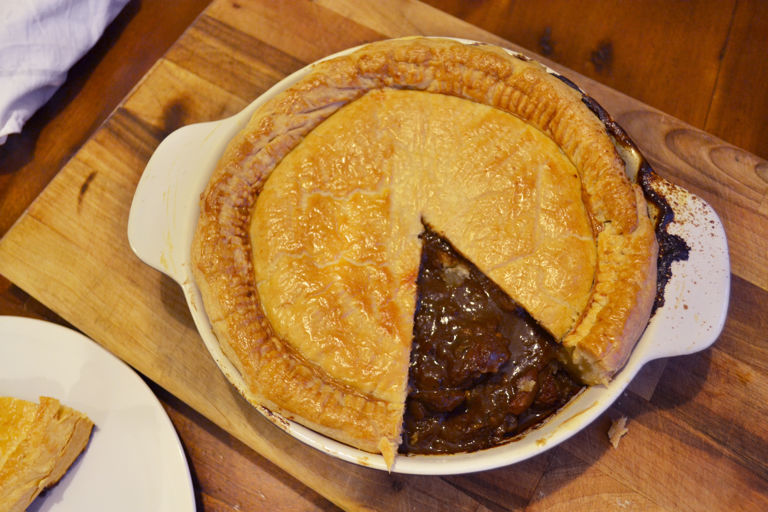Steak and kidney pie with smoked oysters
Food Urchin shares his pie making wisdom, just in time for British Pie Week. He adds a little something to the classic Steak and Kidney pie to make it really something.
How does one improve on a classic such as steak and kidney pie? This is the question that has been vexing my brain of late and when I say that I have spent many a long evening in front of the fire; staring, contemplating, deliberating deeply and smoking my pipe; let me tell you, this picture of solemn thoughtfulness is not an exaggeration.
Well actually, it is an exaggeration. But honestly, I have been thinking a lot about how I could improve upon this humble and economic pie. Some might say if it isn’t broke, don’t fix it. But most recipes could do with a tweak here and there. And by jove, I think I’ve cracked it Watson.
I have of course had some help along the way and when it comes to looking for inspiration, nothing quite beats the hive mind of Twitter. The first suggestion, which came from the kitchen of Clerkenwell Kitchen, was to use the lesser known (in this country at least) onglet steak as the main meaty component of the pie. Also known as ‘hanger steak’ this dense cut comes from the diaphragm of the cow and is full of rich iron flavour. Some detractors might say that it doesn’t suit long cooking but believe me, this isn’t the case. Chef Emma Miles also recommended using a strong dark ale to braise and to make sure the steak was thoroughly browned first, so that was duly noted.
The second tip or trick that popped up in my timeline came from food writer and pressure cooker campaigner Catherine Phipps and her bold statement was to sling some smoked oysters into the pot. Namely the tinned variety. Now this practise isn’t as unusual as it sounds, as oysters used to be flung into pies with gay abandon, particularly back in the days of Queen Victoria when they were cheap and plentiful. Plus the idea of adding some smoke to the mix really did appeal, to add some extra depth to that essential gravy. So in they went too.
However, when it came to the pastry, that’s when things started to turn ugly and all the soapbox merchants started to come out of the closet. “I would go for puff.” “Why not try filo? “It should be suet for gawds’ sake!” And yes, perhaps this pie should have a suet crust, to tie in with the kidney. But I ended up plumping for an easy shortcrust, ready-made too (gasp), to make a buttery, crumbly hat to set upon a ceramic dish and contain the beautiful, bountiful filling within.
Then it really kicked off. “Don’t make a stew with a lid Urchin! I am warning you!” said some chef called Chris Brumby, who professes to know a lot about pies. Because he has like, his own business selling pies. Or something. I have been here before though and I once got into a really heated and vehement argument over the internet with some chap who took umbrage with my enthusiasm for topping with meat with discs of pastry and calling them pies. We very nearly organised to step outside to settle our differences you know. But it turned out that he lived in Germany, so it wasn’t very practical.
It does go to show just how passionate people can get about pies though and if I had to acquiesce, yeah, a proper pie should be really enveloped within a cocoon of flour and fat. But I had the children screaming at me for dinner, so I went for the quick fix. If you have the time though and are looking to make a sumptuous steak and kidney pie for British Pie Week, I would recommend you go the whole hog and make a proper casing.
Finally, after all that, you might well be asking what did I do to add to the mix? Well to make this pie all quirky and different and magical I added in…mushrooms dahling! I added sliced chestnut mushrooms to my steak and kidney pie.
Yep, that’s right and you know what? They tasted delicious so you can get off your high horse right NOW!
As is often the case with stew, you can make the filling a day before if you like and leave in the fridge overnight so that the flavours have time to develop.
Ingredients
Metric
Imperial
- 750g of onglet, chopped into bite-sized chunks
- 400g of ox kidney, cored and chopped into a medium dice
- 1 red onion, diced
- 2 garlic cloves, finely chopped
- 250g of chestnut mushrooms, sliced
- 1 tbsp of tomato purée
- 2 sprigs of thyme, leaves removed and roughly chopped
- 1 bay leaf
- smoked oysters, 1 tin, roughly chopped
- 100g of plain flour
- 300ml of beef stock
- 300ml of ale, dark
- 500g of shortcrust pastry
- 1 egg, beaten
- salt
- black pepper
- butter, for frying
Method
Get in touch
Please sign in or register to send a comment to Great British Chefs.



